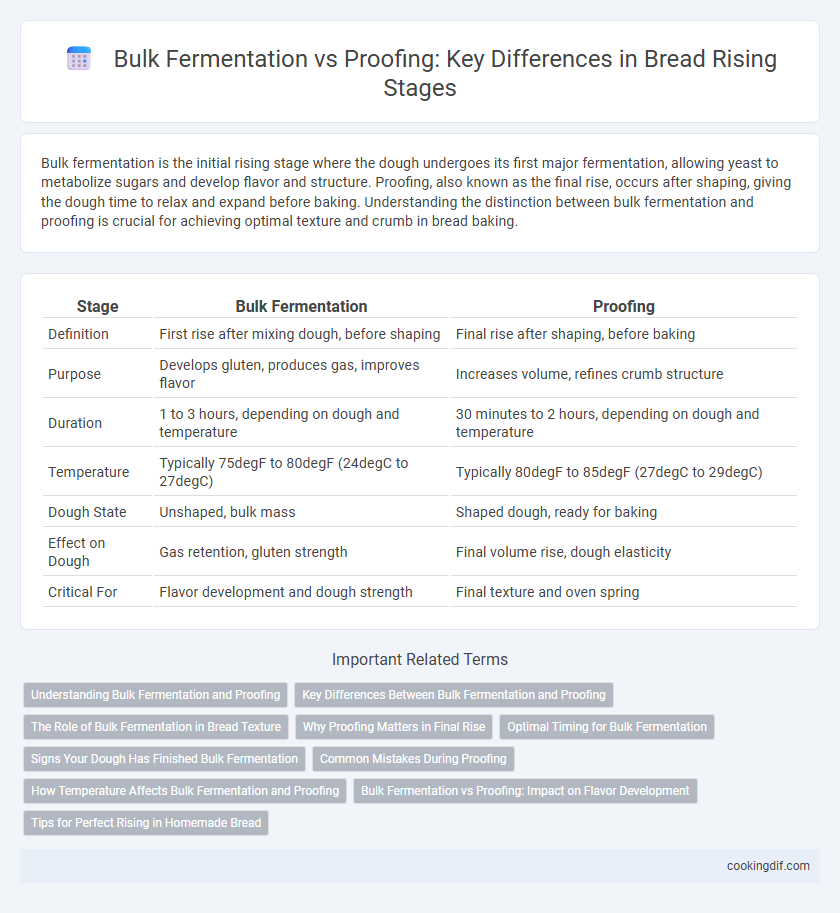Bulk fermentation is the initial rising stage where the dough undergoes its first major fermentation, allowing yeast to metabolize sugars and develop flavor and structure. Proofing, also known as the final rise, occurs after shaping, giving the dough time to relax and expand before baking. Understanding the distinction between bulk fermentation and proofing is crucial for achieving optimal texture and crumb in bread baking.
Table of Comparison
| Stage | Bulk Fermentation | Proofing |
|---|---|---|
| Definition | First rise after mixing dough, before shaping | Final rise after shaping, before baking |
| Purpose | Develops gluten, produces gas, improves flavor | Increases volume, refines crumb structure |
| Duration | 1 to 3 hours, depending on dough and temperature | 30 minutes to 2 hours, depending on dough and temperature |
| Temperature | Typically 75degF to 80degF (24degC to 27degC) | Typically 80degF to 85degF (27degC to 29degC) |
| Dough State | Unshaped, bulk mass | Shaped dough, ready for baking |
| Effect on Dough | Gas retention, gluten strength | Final volume rise, dough elasticity |
| Critical For | Flavor development and dough strength | Final texture and oven spring |
Understanding Bulk Fermentation and Proofing
Bulk fermentation is the initial rising stage where yeast activity produces carbon dioxide, causing the dough to expand and develop flavor complexity. Proofing is the final rise after shaping, allowing the dough to rest and achieve optimal volume for baking. Understanding these stages ensures proper dough texture, crumb structure, and overall bread quality.
Key Differences Between Bulk Fermentation and Proofing
Bulk fermentation is the initial rise after mixing dough where yeast activity generates gas and develops gluten structure, typically lasting several hours. Proofing, also known as the final rise, occurs after shaping, allowing dough to expand and improve texture before baking. The key difference lies in timing and purpose: bulk fermentation focuses on flavor and gluten development, while proofing primarily targets dough expansion and final crumb refinement.
The Role of Bulk Fermentation in Bread Texture
Bulk fermentation significantly influences bread texture by allowing yeast activity to develop gluten structure and gas retention uniformly throughout the dough. During this stage, enzymatic processes break down starches and proteins, enhancing flavor complexity and crumb softness. Proper bulk fermentation time ensures a well-aerated dough, resulting in a tender crumb and desirable chewiness before shaping and proofing.
Why Proofing Matters in Final Rise
Proofing matters in the final rise because it allows yeast to produce carbon dioxide, creating the bread's texture and volume. This stage also enables gluten relaxation, which improves dough extensibility and results in a lighter crumb. Proper proofing ensures optimal oven spring and prevents dense, under-risen bread.
Optimal Timing for Bulk Fermentation
Optimal timing for bulk fermentation in bread making typically ranges from 1 to 3 hours at room temperature, allowing yeast to fully develop flavor and dough strength. Under-fermentation results in dense texture, while over-fermentation causes excessive gas production and weakened gluten structure. Monitoring dough volume, usually doubling in size, serves as a key indicator for ending bulk fermentation and moving to the proofing stage.
Signs Your Dough Has Finished Bulk Fermentation
Signs your dough has finished bulk fermentation include noticeable expansion, typically doubling in size, and a surface that appears slightly domed with small air bubbles visible under the crust. The dough should feel aerated and soft, with a slight spring-back when gently pressed, indicating the gluten has developed adequately. A fermented aroma, slightly tangy or yeasty, is another key indicator that bulk fermentation is complete, readying the dough for shaping and proofing.
Common Mistakes During Proofing
Common mistakes during proofing include under-proofing, which results in dense, heavy bread, and over-proofing, causing the dough to collapse and produce coarse texture. Temperature inconsistencies and ignoring dough elasticity can also hinder proper yeast activity during proofing. Monitoring dough rise time and finger-test elasticity are essential for achieving ideal crumb structure and oven spring.
How Temperature Affects Bulk Fermentation and Proofing
Temperature critically influences bulk fermentation and proofing by controlling yeast activity and enzyme function responsible for dough rise. Warmer temperatures, typically between 75degF and 85degF, accelerate yeast metabolism during bulk fermentation, leading to faster gas production and gluten development, while cooler temperatures slow this process, allowing for enhanced flavor complexity. During proofing, maintaining consistent warmth ensures optimal dough expansion and crumb structure, while excessive heat can cause over-proofing, resulting in a dense loaf with poor oven spring.
Bulk Fermentation vs Proofing: Impact on Flavor Development
Bulk fermentation allows yeast to metabolize sugars more thoroughly, producing complex flavor compounds and enhancing the bread's depth and aroma. Proofing primarily focuses on final dough expansion and gas retention, contributing to texture but less to flavor complexity. Extended bulk fermentation times promote superior fermentation byproducts like organic acids, which significantly enrich taste profiles compared to shorter proofing periods.
Tips for Perfect Rising in Homemade Bread
Bulk fermentation, the initial rise after mixing dough, is crucial for flavor and texture development, requiring consistent temperature around 75-78degF (24-26degC) and humidity near 75% to optimize yeast activity. Proofing, the final rise before baking, benefits from a slightly warmer environment, approximately 80-85degF (27-29degC), to maximize dough volume without overproofing, which can cause dense bread. Monitoring dough elasticity and using a poke test during both stages help ensure perfect rising and a superior crumb structure in homemade bread.
Bulk Fermentation vs Proofing for rising stages Infographic

 cookingdif.com
cookingdif.com